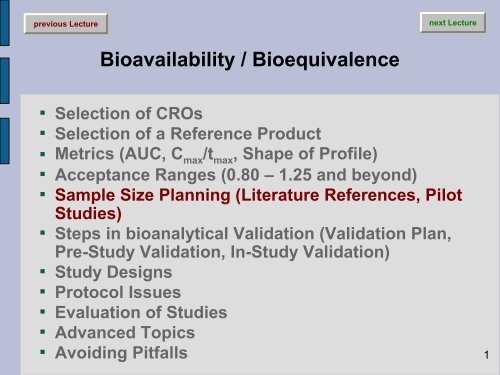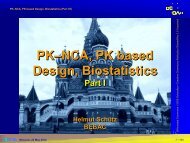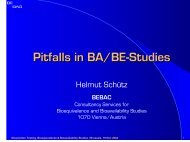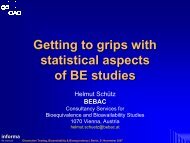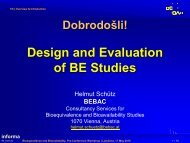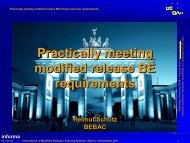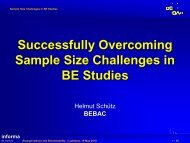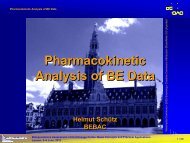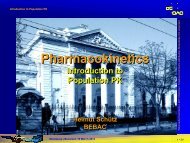Steps in bioanalytical Validation
Steps in bioanalytical Validation
Steps in bioanalytical Validation
- No tags were found...
Create successful ePaper yourself
Turn your PDF publications into a flip-book with our unique Google optimized e-Paper software.
Bioavailability / BioequivalenceSelection of CROsSelection of a Reference ProductMetrics (AUC, C max/t max, Shape of Profile)Acceptance Ranges (0.80 – 1.25 and beyond)Sample Size Plann<strong>in</strong>g (Literature References, PilotStudies)<strong>Steps</strong> <strong>in</strong> <strong>bioanalytical</strong> <strong>Validation</strong> (<strong>Validation</strong> Plan,Pre-Study <strong>Validation</strong>, In-Study <strong>Validation</strong>)Study DesignsProtocol IssuesEvaluation of StudiesAdvanced TopicsAvoid<strong>in</strong>g Pitfalls1
Bioavailability / BioequivalenceSample Size Plann<strong>in</strong>g (Literature References,Pilot Studies)●Suggested ReferencesS.-C. Chow and J.-p. Liu;Design and Analysis of Bioavailability and BioequivalenceStudies.Marcel Dekker, New York (2 nd ed. 2000)S.-C. Chow, Shao, J. and H. Wang;Sample Size Calculations In Cl<strong>in</strong>ical Research.Marcel Dekker, New York (2003)2
Bioavailability / BioequivalenceSample Size Plann<strong>in</strong>g (Literature References,Pilot Studies)●The number of subjects required is determ<strong>in</strong>ed bythe error variance associated with the primary characteristicto be studied as estimated from➔➔➔a pilot experiment,previous studies, orpublished data,the significance level desired,the expected deviation (∆) from the reference product compatiblewith BE and,the required power.3
Bioavailability / BioequivalenceSample Size Plann<strong>in</strong>g (Literature References,Pilot Studies)●Problems/Solutions… the error variance associated with the primary characteristicto be studied …➔ S<strong>in</strong>ce BE must be shown both for AUC and Cmax , and➔if you plan your sample size only for the ‘primary characteristic’(e.g., AUC), <strong>in</strong> many cases you will fail for the secondaryparameter (e.g., C max), which most likely shows highervariability – your study will be underpowered.➔Based on the assumption, that CV is identical for test andreference (what if only the reference formulation has highvariability, e.g., ∗prazoles?).4
Bioavailability / BioequivalenceSample Size Plann<strong>in</strong>g (Literature References,Pilot Studies)●The number of subjects required is determ<strong>in</strong>ed bythe error variance associated with the primary characteristicto be studied as estimated from➔➔➔a pilot experiment,previous studies, orpublished data,the significance level desired,the expected deviation (∆) from the reference product compatiblewith BE and,the required power.5
Bioavailability / BioequivalenceSample Size Plann<strong>in</strong>g (Literature References,Pilot Studies)●Problems/Solutions… as estimated from➔➔➔a pilot experiment,previous studies, orpublished data,The correct order should read:previous studies → pilot study → published data.➔➔➔Only <strong>in</strong> the first case you ‘know’ all constra<strong>in</strong>ts result<strong>in</strong>g <strong>in</strong>variability.Pilot studies are often too small to get reliable estimates ofvariability.Advisable only if you have data from a couple of studies.6
Bioavailability / BioequivalenceSample Size Plann<strong>in</strong>g (Literature References,Pilot Studies)●The number of subjects required is determ<strong>in</strong>ed bythe error variance associated with the primary characteristicto be studied as estimated from➔➔➔a pilot experiment,previous studies, orpublished data,the significance level desired,the expected deviation (∆) from the reference product compatiblewith BE and,the required power.7
Bioavailability / BioequivalenceSample Size Plann<strong>in</strong>g (Literature References,Pilot Studies)●Problems/Solutions… the significance level desired…➔➔➔Throughout the NfG the significance level (α, error type I:patient’s risk to be treated with an bio<strong>in</strong>equivalent drug) isfixed to 5 % (correspond<strong>in</strong>g to a 90 % confidence <strong>in</strong>terval).Only <strong>in</strong> some very restrictive legislations (e.g., Brazil’sANVISA), α must be tightened to 2.5 % for NTIDs (95 %confidence <strong>in</strong>terval).You may desire a lower significance level, but you will notget an approval anywhere!8
Bioavailability / BioequivalenceSample Size Plann<strong>in</strong>g (Literature References,Pilot Studies)●The number of subjects required is determ<strong>in</strong>ed bythe error variance associated with the primary characteristicto be studied as estimated from➔➔➔a pilot experiment,previous studies, orpublished data,the significance level desired,the expected deviation (∆) from the reference product compatiblewith BE and,the required power.9
Bioavailability / BioequivalenceSample Size Plann<strong>in</strong>g (Literature References,Pilot Studies)●Problems/Solutions… the expected deviation (∆ ) from the reference…➔➔➔➔Reliable estimate only from a previous full-sized study.If you are us<strong>in</strong>g data from a pilot study, allow for a safetymarg<strong>in</strong>.If no data are available, commonly a test/reference-ratio of0.95 (∆ = 5 %) is used.If more than ∆ = 10 % is expected, questions from the EthicsCommittee are likely.10
Bioavailability / BioequivalenceSample Size Plann<strong>in</strong>g (Literature References,Pilot Studies)●The number of subjects required is determ<strong>in</strong>ed bythe error variance associated with the primary characteristicto be studied as estimated from➔➔➔a pilot experiment,previous studies, orpublished data,the significance level desired,the expected deviation (∆) from the reference product compatiblewith BE and,the required power.11
Bioavailability / BioequivalenceSample Size Plann<strong>in</strong>g (Literature References,Pilot Studies)●Problems/Solutions… the required power.➔➔➔➔Generally the power is set to at least 80 % (β, error type II:producers’s risk to get no approval for a bioequivalent drug;power = 1 – β).Remember: 1 out of 5 studies will fail!If you plan for power of less than 70 %, problems with theEthics Committee are likely.If you plan for power of more than 90 % (especially with lowvariability drugs), problems with the Regulator are likely(‘forced bioequivalence’).Add subjects accord<strong>in</strong>g to the expected drop-out rate.12
Bioavailability / BioequivalenceSample Size Plann<strong>in</strong>g (Literature References)●Literature ReferencesShould be applied with caution (same dosage level andregimen, s<strong>in</strong>gle dose / multiple dose, analytical method,log-transformed data, year of publication,…).Preferable pooled data form a couple of studies.Blume, H. and E. Mutschler (eds., <strong>in</strong> German only);Bioäquivalenz. Qualitätsbewertung wirkstoffgleicher Fertigarzneimittel.Anleitung – Methoden – Materialien.GOVI, Frankfurt/Eschborn, loose-leaf-collection (1989-1996)Ste<strong>in</strong>ijans, V.W. et al.;Reference tables for the <strong>in</strong>trasubject coefficient of variation <strong>in</strong> bioequivalencestudies.Int. J. Cl<strong>in</strong>. Pharm. Therap. 33(8), 427-430 (1995)13
Bioavailability / BioequivalenceSample Size Plann<strong>in</strong>g (Literature References)37 BE-studies from Blume/Mutschler (doxicycl<strong>in</strong>e)frequency12108642010 15 20 25 30total100 mg200 mg%CV14
Bioavailability / BioequivalenceSample Size Plann<strong>in</strong>g (Pilot Studies)●Pilot StudiesOnly reasonably large study (e.g., n=16) helpful for theselection of the ‘best’ of several similar formulations.Estimates of PK parameters from small studies have largeconfidence <strong>in</strong>tervals.Estimate of the <strong>in</strong>trasubject variance even more uncerta<strong>in</strong>.15
Bioavailability / BioequivalenceSample Size Plann<strong>in</strong>g (Pilot Studies)upper 95 % CL / CVmean200%175%150%125%100%Estimates of <strong>in</strong>trasubject variance (39 studies)12 18 24 30 36sample size16
Bioavailability / BioequivalenceSample Size Plann<strong>in</strong>g (Pilot Studies)[0.80 – 1.25] CV=20% n=24100%90%power80%70%60%50%0.85 0.90 0.95 1.00 1.05 1.10 1.15expected BE ratio17
Bioavailability / BioequivalenceSample Size Plann<strong>in</strong>g (Literature References,Pilot Studies)●Estimation of Sample SizeTables➔➔Diletti, E., Hauschke, D. and V.W. Ste<strong>in</strong>jans;Sample size determ<strong>in</strong>ation for bioequivalence assessmentby means of confidence <strong>in</strong>tervals.Int. J. Cl<strong>in</strong>. Pharm. Ther. Toxicol. 29(1), 1-8 (1991)Diletti, E., Hauschke, D. and V.W. Ste<strong>in</strong>jans;Sample size determ<strong>in</strong>ation: Extended tables for the multiplicativemodel and bioequivalence ranges of 0.9 to 1.11 and0.7 to 1.43.Int. J. Cl<strong>in</strong>. Pharm. Ther. Toxicol. 30/Suppl.1, S59-62 (1992)18
Bioavailability / BioequivalenceSample Size Plann<strong>in</strong>g (Literature References,Pilot Studies)●Estimation of Sample SizeApproximations (may be implemented <strong>in</strong> a Spreadsheet)➔➔Hauschke, D. et al.;Sample Size Determ<strong>in</strong>ation for Bioequivalence AssessmentUs<strong>in</strong>g a Multiplicative Model.J. Pharmacok<strong>in</strong>. Biopharm. 20(5), 557-561 (1992)Chow, S.-C. and H. Wang;On Sample Size Calculation <strong>in</strong> Bioequivalence Trials.J. Pharmacok<strong>in</strong>. Pharmacodyn. 28(2), 155-169 (2001)Errata: J. Pharmacok<strong>in</strong>. Pharmacodyn.29(2), 101-102 (2002)19
Bioavailability / BioequivalenceSample Size Plann<strong>in</strong>g (Literature References,Pilot Studies)●Estimation of Sample SizePrograms➔nQuery Advisorv6.01, Statistical Solutions (2005)➔ PASSv2005, NCSS (2005)➔STATISTICA Power Analysisv7, StatSoft (2005)➔ StudySizev1.09, CreoStat (2004)➔Formulas may be programmed <strong>in</strong> any language/packagewhich supports the noncentral t-distribution (SAS, S+, R,…)20
Bioavailability / BioequivalenceSelection of CROsSelection of a Reference ProductMetrics (AUC, C max/t max, Shape of Profile)Acceptance Ranges (0.80 – 1.25 and beyond)Sample Size Plann<strong>in</strong>g (Literature References, PilotStudies)<strong>Steps</strong> <strong>in</strong> <strong>bioanalytical</strong> <strong>Validation</strong> (<strong>Validation</strong> Plan,Pre-Study <strong>Validation</strong>, In-Study <strong>Validation</strong>)Study DesignsProtocol IssuesEvaluation of StudiesAdvanced TopicsAvoid<strong>in</strong>g Pitfalls21
Bioavailability / Bioequivalence<strong>Steps</strong> <strong>in</strong> <strong>bioanalytical</strong> <strong>Validation</strong> (<strong>Validation</strong>Plan, Pre-Study <strong>Validation</strong>, In-Study <strong>Validation</strong>)●Essential DocumentsThe European Agency for the Evaluation of Medic<strong>in</strong>al Products, HumanMedic<strong>in</strong>es Evaluation Unit;CPMP/ICH/381/95: ICH Q2A Note for Guidance on <strong>Validation</strong> of AnalyticalMethods: Def<strong>in</strong>itions and Term<strong>in</strong>ology. Step 5 (November 1994)The European Agency for the Evaluation of Medic<strong>in</strong>al Products, HumanMedic<strong>in</strong>es Evaluation Unit;CPMP/ICH/281/95: ICH Q2B Note for Guidance on <strong>Validation</strong> of AnalyticalMethods: Methodology. Step 4 (November 1996)Food and Drug Adm<strong>in</strong>istration: Center for Drug Evaluation and Research(CDER), Center for Veter<strong>in</strong>ary Medic<strong>in</strong>e (CVM);Guidance for Industry. Bioanalytical Method <strong>Validation</strong>. (May 2001)22
Bioavailability / Bioequivalence<strong>Steps</strong> <strong>in</strong> <strong>bioanalytical</strong> <strong>Validation</strong> (<strong>Validation</strong>Plan, Pre-Study <strong>Validation</strong>, In-Study <strong>Validation</strong>)●Useful DocumentsCartwright, A.C. et al.;International harmonization and consensus DIA meet<strong>in</strong>g on bioavailabilityand bioequivalence test<strong>in</strong>g requirements and standards.Drug Information Journal 25, 471 (1991)Shah, V.P. et al.;Analytical methods validation: Bioavailability, bioequivalence andpharmacok<strong>in</strong>etic studies.Int. J. Pharm. 82, 1-7 (1992)Shah, V.P., et al.;Bioanalytical Method <strong>Validation</strong> – A Revisit with a Decade of Progress.Pharm. Res. 17, 1551-1557 (2000)23
Bioavailability / Bioequivalence<strong>Steps</strong> <strong>in</strong> <strong>bioanalytical</strong> <strong>Validation</strong> (<strong>Validation</strong>Plan, Pre-Study <strong>Validation</strong>, In-Study <strong>Validation</strong>)●Useful DocumentsOrganisation for Economic Co-operation and Development, EnvironmentDirectorate / Chemicals Group and Management Committee;OECD Pr<strong>in</strong>ciples on Good Laboratory Practice (as revised <strong>in</strong> 1997)Document ENV/MC/CHEM(98)17In: OECD Series on Pr<strong>in</strong>ciples of Good Laboratory Practice and ComplianceMonitor<strong>in</strong>g, Paris, 21-Jan-1998Brazilian Sanitary Surveillance Agency (ANVISA);Manual for Good Bioavailability and Bioequivalence Studies.Volume 1, Module 2: Analytical Step.https://www.anvisa.gov.br/eng/bio/manual/volume1.zipBrasília (2000)24
Bioavailability / Bioequivalence<strong>Steps</strong> <strong>in</strong> <strong>bioanalytical</strong> <strong>Validation</strong>: <strong>Validation</strong> Plan●Method used for quantitative measurement ofanalytes <strong>in</strong> a given biological matrix must be reliableand reproducible for the <strong>in</strong>tended use.AccurracyPrecisionSelectivitySensitivityReproducibilityStability25
Bioavailability / Bioequivalence<strong>Steps</strong> <strong>in</strong> <strong>bioanalytical</strong> <strong>Validation</strong>: <strong>Validation</strong> Plan●Full <strong>Validation</strong>Develop<strong>in</strong>g and implement<strong>in</strong>g a new <strong>bioanalytical</strong> method,or add<strong>in</strong>g metabolites to an exist<strong>in</strong>g assay.➔ SelectivityLack of <strong>in</strong>terferences above the Lower Limit of Quantitation(LLOQ) <strong>in</strong> ≥6 different sources of matrix.➔ AccuracyReplicate (≥5) analysis of known concentrations measuredat ≥3 levels (low, <strong>in</strong>termediate, high).Mean values with<strong>in</strong> ±15 % of expected (except at LLOQ,where ±20 % is acceptable).26
Bioavailability / Bioequivalence<strong>Steps</strong> <strong>in</strong> <strong>bioanalytical</strong> <strong>Validation</strong>: <strong>Validation</strong> Plan●Full <strong>Validation</strong>Develop<strong>in</strong>g and implement<strong>in</strong>g a new <strong>bioanalytical</strong> method,or add<strong>in</strong>g metabolites to an exist<strong>in</strong>g assay.➔ PrecisionReplicate (≥5) analysis of known concentrations measuredat ≥3 levels (low, <strong>in</strong>termediate, high).Coefficient of Variation (CV) ≤15 % at each concentration(except at LLOQ, where ≤20 % is acceptable).●<strong>in</strong>tra-batchwith<strong>in</strong> analytical run.●<strong>in</strong>ter-batchbetween analytical runs (aka repeatability).27
Bioavailability / Bioequivalence<strong>Steps</strong> <strong>in</strong> <strong>bioanalytical</strong> <strong>Validation</strong>: <strong>Validation</strong> Plan●Full <strong>Validation</strong>Develop<strong>in</strong>g and implement<strong>in</strong>g a new <strong>bioanalytical</strong> method,or add<strong>in</strong>g metabolites to an exist<strong>in</strong>g assay.➔ RecoveryThe detector response obta<strong>in</strong>ed from an amount of the analyteadded to and extracted from the biological matrix, comparedto the detector response obta<strong>in</strong>ed for the true concentrationof the pure authentic standard. Recovery of the analyteneed not be 100 %, but the extent of recovery of an analyteand of the <strong>in</strong>ternal standard should be consistent, precise,and reproducible..Measured at low/<strong>in</strong>termediate/high level.28
Bioavailability / Bioequivalence<strong>Steps</strong> <strong>in</strong> <strong>bioanalytical</strong> <strong>Validation</strong>: <strong>Validation</strong> Plan●Full <strong>Validation</strong>Develop<strong>in</strong>g and implement<strong>in</strong>g a new <strong>bioanalytical</strong> method,or add<strong>in</strong>g metabolites to an exist<strong>in</strong>g assay.➔Calibration/Standard CurveSame matrix as the samples <strong>in</strong> the <strong>in</strong>tended study spikedwith known concentrations. Number of standards: function ofthe anticipated range of analytical values, nature of theanalyte/response relationship. Concentrations of standardschosen on basis of the concentration range expected.●Blank sample (matrix sample processed without <strong>in</strong>ternalstandard),●Zero sample (matrix sample processed with <strong>in</strong>ternal standard),●6 – 8 non-zero samples cover<strong>in</strong>g the expected range, <strong>in</strong>clud<strong>in</strong>gLLOQ.29
Bioavailability / Bioequivalence<strong>Steps</strong> <strong>in</strong> <strong>bioanalytical</strong> <strong>Validation</strong>: <strong>Validation</strong> Plan●Full <strong>Validation</strong>Develop<strong>in</strong>g and implement<strong>in</strong>g a new <strong>bioanalytical</strong> method,or add<strong>in</strong>g metabolites to an exist<strong>in</strong>g assay.➔Calibration/Standard Curve●Simplest model that adequately describes the concentrationresponserelationship should be used.●Selection of weight<strong>in</strong>g and use of a complex regressionequation should be justified.●Response at LLOQ ≥5 times response of blank.●●Response at LLOQ: precision ≤20 %, accuracy ±20 % fromnom<strong>in</strong>al concentration.Response at other levels: accuracy ±15 % from nom<strong>in</strong>alconcentration.30
Bioavailability / Bioequivalence<strong>Steps</strong> <strong>in</strong> <strong>bioanalytical</strong> <strong>Validation</strong>: <strong>Validation</strong> Plan●Full <strong>Validation</strong>Develop<strong>in</strong>g and implement<strong>in</strong>g a new <strong>bioanalytical</strong> method,or add<strong>in</strong>g metabolites to an exist<strong>in</strong>g assay.➔Calibration/Standard Curve●At least four out of six non-zero standards should meet theabove criteria, <strong>in</strong>clud<strong>in</strong>g the LLOQ and the calibration standardat the highest concentration.●Exclud<strong>in</strong>g the standards should not change the model used.31
Bioavailability / Bioequivalence<strong>Steps</strong> <strong>in</strong> <strong>bioanalytical</strong> <strong>Validation</strong>: <strong>Validation</strong> Plan●Full <strong>Validation</strong>Develop<strong>in</strong>g and implement<strong>in</strong>g a new <strong>bioanalytical</strong> method,or add<strong>in</strong>g metabolites to an exist<strong>in</strong>g assay.➔ StabilityStability of the analytes dur<strong>in</strong>g sample collection andhandl<strong>in</strong>g.●Three freeze-thaw cycles≥3 aliquots at low and high levels stored for 24 hours andthawed at room temperature. When completely thawed, refrozenfor 12 – 24 hours. This cycle two more times repeated, thenanalyzed after the third cycle. If <strong>in</strong>stable: samples should befrozen at -70 °C dur<strong>in</strong>g another FT-cylce.32
Bioavailability / Bioequivalence<strong>Steps</strong> <strong>in</strong> <strong>bioanalytical</strong> <strong>Validation</strong>: <strong>Validation</strong> Plan●Full <strong>Validation</strong>Develop<strong>in</strong>g and implement<strong>in</strong>g a new <strong>bioanalytical</strong> method,or add<strong>in</strong>g metabolites to an exist<strong>in</strong>g assay.➔ StabilityStability of the analytes dur<strong>in</strong>g sample collection andhandl<strong>in</strong>g.●Short-Term Storage (bench top, room temperature):Three aliquots of each of the low and high concentrationsshould be thawed at room temperature and kept at this temperaturefrom 4 – 24 hours (based on the expected duration thatsamples will be ma<strong>in</strong>ta<strong>in</strong>ed at room temperature <strong>in</strong> the <strong>in</strong>tendedstudy) and analyzed.33
Bioavailability / Bioequivalence<strong>Steps</strong> <strong>in</strong> <strong>bioanalytical</strong> <strong>Validation</strong>: <strong>Validation</strong> Plan●Full <strong>Validation</strong>Develop<strong>in</strong>g and implement<strong>in</strong>g a new <strong>bioanalytical</strong> method,or add<strong>in</strong>g metabolites to an exist<strong>in</strong>g assay.➔ StabilityStability of the analytes dur<strong>in</strong>g sample collection andhandl<strong>in</strong>g.●Long-Term Storage (frozen at the <strong>in</strong>tended storagetemperature) should exceed the time between the date of firstsample collection and the date of last sample analysis.Determ<strong>in</strong>ed by stor<strong>in</strong>g ≥3 aliquots of low/high levels under thesame conditions as the study samples. Volume should be sufficientfor analysis on 3 separate occasions. Concentrations of allthe stability samples should be compared to the mean of backcalculatedvalues for the standards at the appropriate concentrationsfrom the first day of long-term stability test<strong>in</strong>g.34
Bioavailability / Bioequivalence<strong>Steps</strong> <strong>in</strong> <strong>bioanalytical</strong> <strong>Validation</strong>: <strong>Validation</strong> Plan●Full <strong>Validation</strong>Develop<strong>in</strong>g and implement<strong>in</strong>g a new <strong>bioanalytical</strong> method,or add<strong>in</strong>g metabolites to an exist<strong>in</strong>g assay.➔ StabilityStability of the analytes dur<strong>in</strong>g sample collection andhandl<strong>in</strong>g.●Stock Solution Stability of drug and the <strong>in</strong>ternal standardshould be evaluated at room temperature for ≥6 hours. If thestock solutions are refrigerated or frozen for the relevant period,the stability should be documented. After completion of the desiredstorage time, the stability should be tested by compar<strong>in</strong>gthe <strong>in</strong>strument response with that of freshly prepared solutions.35
Bioavailability / Bioequivalence<strong>Steps</strong> <strong>in</strong> <strong>bioanalytical</strong> <strong>Validation</strong>: <strong>Validation</strong> Plan●Full <strong>Validation</strong>Develop<strong>in</strong>g and implement<strong>in</strong>g a new <strong>bioanalytical</strong> method,or add<strong>in</strong>g metabolites to an exist<strong>in</strong>g assay.➔ StabilityStability of the analytes dur<strong>in</strong>g sample collection andhandl<strong>in</strong>g.●Post-Preparative StabilityStability of processed samples, <strong>in</strong>clud<strong>in</strong>g the resident time <strong>in</strong> theautosampler, should be determ<strong>in</strong>ed. The stability of the drugand the <strong>in</strong>ternal standard should be assessed over the anticipatedrun time for the batch size <strong>in</strong> validation samples by determ<strong>in</strong><strong>in</strong>gconcentrations on the basis of orig<strong>in</strong>al calibration standards.36
Bioavailability / Bioequivalence<strong>Steps</strong> <strong>in</strong> <strong>bioanalytical</strong> <strong>Validation</strong>: <strong>Validation</strong> Plan●Partial <strong>Validation</strong>Method transfers between laboratories (or analysts).Change <strong>in</strong> analytical methodology (e.g., change <strong>in</strong>detection systems).Change <strong>in</strong> anticoagulant <strong>in</strong> harvest<strong>in</strong>g biological fluid.Change <strong>in</strong> matrix with<strong>in</strong> species (e.g., human plasma tohuman ur<strong>in</strong>e).Change <strong>in</strong> sample process<strong>in</strong>g procedures.Change <strong>in</strong> species with<strong>in</strong> matrix (e.g., rat plasma to mouseplasma).37
Bioavailability / Bioequivalence<strong>Steps</strong> <strong>in</strong> <strong>bioanalytical</strong> <strong>Validation</strong>: <strong>Validation</strong> Plan●Partial <strong>Validation</strong>Change <strong>in</strong> relevant concentration range.Changes <strong>in</strong> <strong>in</strong>struments and/or software platforms.Limited sample volume (e.g., pediatric study).Rare matrices.Selectivity demonstration of an analyte <strong>in</strong> the presence ofconcomitant medications and/or specific metabolites.38
Bioavailability / Bioequivalence<strong>Steps</strong> <strong>in</strong> <strong>bioanalytical</strong> <strong>Validation</strong>: <strong>Validation</strong> Plan●Cross-<strong>Validation</strong>Comparison of validation parameters when two or more<strong>bioanalytical</strong> methods are used to generate data with<strong>in</strong> thesame study or across different studies. An example ofcross-validation would be a situation where an orig<strong>in</strong>al validated<strong>bioanalytical</strong> method serves as the reference and therevised <strong>bioanalytical</strong> method is the comparator.Cross-validation should also be considered when datagenerated us<strong>in</strong>g different analytical techniques (e.g.,LC-MS/MS vs. ELISA) <strong>in</strong> different studies are <strong>in</strong>cluded <strong>in</strong> aregulatory submission.39
Bioavailability / Bioequivalence<strong>Steps</strong> <strong>in</strong> <strong>bioanalytical</strong> <strong>Validation</strong>: <strong>Validation</strong> Plan●Cross-<strong>Validation</strong>, Example: Cl<strong>in</strong>damyc<strong>in</strong>concentration [ng/ml]100000100001000100cl<strong>in</strong>damyc<strong>in</strong> 600 mg p.o.HPLC/UV (n=24)t½: 5.61 h; r=0.981GC/MS (n=20)t½: 2.22 h; r=0.999LOQ: 20 ng/ml100 4 8 12 16 20 24time [h]40
Bioavailability / Bioequivalence<strong>Steps</strong> <strong>in</strong> <strong>bioanalytical</strong> <strong>Validation</strong>: <strong>Validation</strong> PlanHLPC/UV [ng/ml]●Cross-<strong>Validation</strong>, Example: Cl<strong>in</strong>damyc<strong>in</strong>4000300020001000y=25.947+0.957*x+epsHLPC/UV [ng/ml]15010000 1000 2000 3000 4000LC-MS/MS [ng/ml] 50y=11.964+0.908*x+eps00 50 100 150LC-MS/MS [ng/ml]41
Bioavailability / Bioequivalence<strong>Steps</strong> <strong>in</strong> <strong>bioanalytical</strong> <strong>Validation</strong>: <strong>Validation</strong> Plan●Written Document describ<strong>in</strong>g which steps will beperformed <strong>in</strong> the <strong>Validation</strong>.Purpose of <strong>Validation</strong> (e.g., ‘<strong>Validation</strong> of <strong>bioanalytical</strong>method X for the determ<strong>in</strong>ation of Y <strong>in</strong> human plasma’).Reference to already established method (SOP).42
Bioavailability / Bioequivalence<strong>Steps</strong> <strong>in</strong> <strong>bioanalytical</strong> <strong>Validation</strong>:Pre-Study <strong>Validation</strong>●Performance of <strong>Validation</strong> accord<strong>in</strong>g to the<strong>Validation</strong> Plan.Results must comply with limits set <strong>in</strong> the <strong>Validation</strong> Plan.●Report of Results‘Method <strong>Validation</strong> Report’.Will be referred <strong>in</strong> the Analytical Protocol of BA/BE-studies.43
Bioavailability / Bioequivalence<strong>Steps</strong> <strong>in</strong> <strong>bioanalytical</strong> <strong>Validation</strong>:In-Study <strong>Validation</strong>●Study Samples should be analyzed accord<strong>in</strong>g tothe Analytical Protocol.Quality Control Samples (QCs) should be analyzedtogether with Calibrators and study samples.➔Low / <strong>in</strong>termediate / high concentration levelsAt least Duplicates at each level.Low:with<strong>in</strong> 3times the LLOQ.Intermediate: near the center of the calibration range.High:near the upper boundary.44
Bioavailability / Bioequivalence<strong>Steps</strong> <strong>in</strong> <strong>bioanalytical</strong> <strong>Validation</strong>:In-Study <strong>Validation</strong>●Study Samples should be analyzed accord<strong>in</strong>g tothe Analytical Protocol.Acceptance Criteria for an analytical run➔ QCs85 % – 115 % accuracy for s<strong>in</strong>gle determ<strong>in</strong>ations of QCs;not more than two different of six per run should be out ofrange.➔Standard Curve85 % – 115 % accuracy for 75 % of standard po<strong>in</strong>ts, exceptfor LLOQ (80 % – 120 %). Values outside can be discarded,provided they do not change the established model.45


